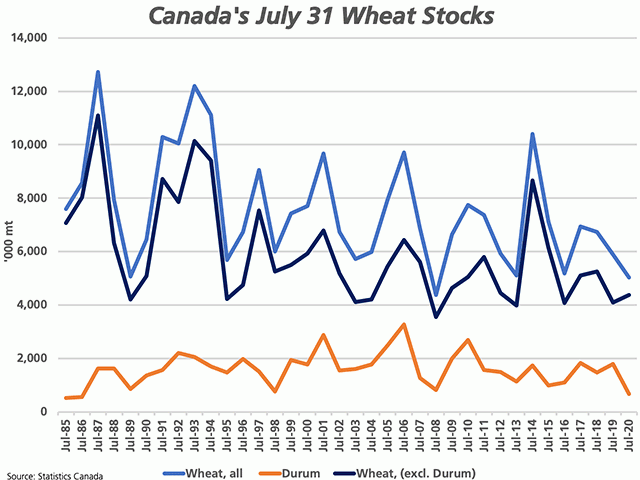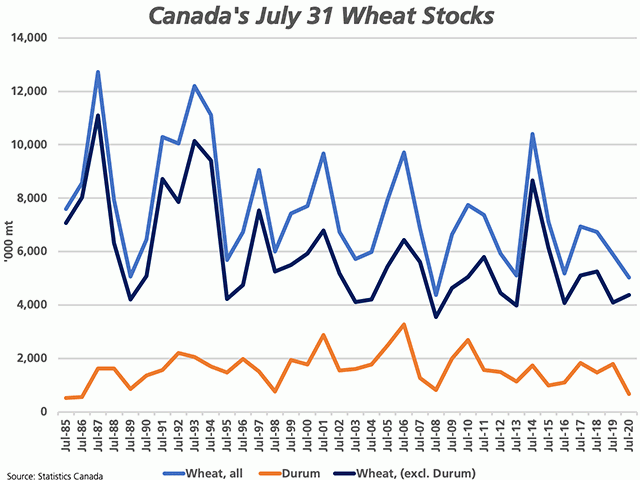Canada Markets
Statistics Canada's July 31 Grain Stocks Report
September 4 marks the release of the last of the series of Statistics Canada's Field Crop Reports for the 2019-20 crop year. Today's report focuses on the July 31 stocks for all crops except for corn and soybeans, where the crop year ends one month later.
The stocks report is important in that it signals the ending point for 2019-20, which in turn becomes the starting point or beginning stocks for 2020-21, making up a key component in the supplies calculation. As well, it signals late-crop-year demand as an indication of what may follow in 2020-21.
Canada's all-wheat stocks were estimated at 5.028 million metric tons, down 14.6% from the previous crop year and 21% lower than the five-year average. This is the third consecutive annual drop in all-wheat stocks, while the lowest reported in 12 years or since July 2008. As we will soon see, this is entirely due to a sharp drop in durum stocks. Agriculture and Agri-Food Canada had previously estimated this carryout at 5.3 mmt, so today's estimated volume could be viewed as below expectations.
When durum stocks are excluded, wheat stocks were reported at 4.368 mmt, up 6.6% from 2018-19 while 11.4% below the five-year average. Despite the year-over-year increase, stocks remain low when compared to long-term data. This was slightly below AAFC's August forecast of 4.5 mmt. Based on today's estimate, demand in the final four months of the crop year led to disappearance of 10.731 mmt, 15.1% higher than last year and 26% higher than the five-year average.
Export demand remains strong. Weekly Canadian Grain Commission data shows four weeks where weekly volumes exported were in excess of 500,000 mt in the week 40 to week 52 period of 2019-20, a signal of demand that has carried forward into the first four weeks of 2020-21. Based on Statistics Canada's production estimates released earlier in the week, crop year supplies for 2020-21 would total 33.282 mmt, the highest seen in seven years.
Wheat stocks estimates show on farm stocks fell 5.3% year-over-year to 1.614 mmt, the smallest seen in three years, while commercial stocks are seen rising by 15% to 2.754 mmt. Manitoba's farm stocks fell by 66.7% to 50,000 mt, the tightest estimated since July 2008. Saskatchewan's wheat stocks were estimated also at 50,000 mt, down 73.7% from a year ago, while the lowest seen in decades of data. Farm stocks in Alberta rose 16.7% to 1.4 mmt.
P[L1] D[0x0] M[300x250] OOP[F] ADUNIT[] T[]
Durum stocks as of July 31 were reported at 660,000 metric tons, down a whopping 63.2% from July 2019 and 54% below the five-year average. One has to go back to July 1986 to see lower stocks than the estimate for 2020. AAFC's most recent unofficial estimate was released at 800,000 mt. Disappearance over the April through July period was pegged at 2.565 mmt, up 10.3% from 2018-19 and 32.9% above the five-year average. Based on Statistics Canada's production estimate for 2020, crop year supplies would grow to 7.636 mmt, the highest in four years.
Statistics Canada's estimated canola stocks came in at 2.741 mmt, down 34.3% from 2018-19 and 8% higher than the five-year average for this date. This is the first year-over-year drop in stocks seen in three years. This is well-above the 1.825 mmt estimate released by AAFC in August, while understandable given the more than 1 mmt upward revision in production in 2018 and 2019 reported by Statistics Canada earlier this week. Total disappearance over the final four months of the crop year is calculated at 7.423 mmt, up 17.5% from last crop year and 16% higher the five-year average for this period. Based on production estimates released earlier in the week, crop year supplies for 2020-21 are calculated at 22.244 mmt, the lowest in four years, although this remains poised for a downward revision if Statistics Canada finds that high August temperatures trimmed the crop's potential when it releases its next production estimate on Sept 14. Canola's stocks-over-use for 2019-20 is calculated at 13%, down sharply form 20% in the previous crop year.
The agency reported on-farm stocks of canola falling by 51.3% to 1.4 mmt. Manitoba's canola stocks fell by 26.4%, to 405,000 mt. Alberta stocks fell 29% year-over-year to 1.03 mmt, while something fishy appears with Saskatchewan stocks, estimated to fall by 99.8% to just 2,000 mt, an impossibility.
Barley stocks were estimated at 957,000 mt as of July 31, up 10.9% from 2019, but still 30.5% below the five-year average. AAFC's unofficial August estimate was pegged at 1.4 mmt. Today's estimate points to demand over the past four months up 41.8% from last year, at 2.572 mmt, while 18.2% higher than the five-year average. Based on Statistics Canada's current production estimates, 2020-21 supplies of barley are calculated at 11.543 mmt, the highest seen in 11 years.
Oat stocks are reported at 426,000 mt as of July 31, up 7.3% from the previous year and 40% below the five-year average. This is below AAFC's estimate of 600,000 mt. This points to demand over the final four months of the crop year at 1.420 mmt, up 24.6% from last crop year and 32.3% higher than the five-year average. Based on existing production estimates supplies for 2020-21 are calculated at 4.934 mmt, the highest in 12 years.
Dry pea stocks were estimated at 233,000 mt, down for a second year to the lowest level in four years, down 25.3% from the previous crop year and 45% below the five-year average. This is only slightly below the 250,000 mt estimated by ASFC in its August estimates. This signals demand over the past four months of the crop year being 7% higher than the previous crop year and 23.1% higher than the five-year average given an aggressive export program. Based on Statistics Canada's production estimates from earlier in the week, crop year supplies are projected at 5.289 mmt for 2020-21, which would be a record level if achieved and bearish for this market.
Lentil stocks were estimated at 61,000 mt, made possible only by an upward revision in 2019 production by Statistics Canada of 75,100 mt earlier in the week. This volume is down 91.5% from 2019 and 87% below the five-year average, while the lowest July 31 stocks estimated in 10 years. This is higher than the 25,000 mt estimated by AAFC in August. This data points to disappearance in the final four months of the crop year at 1.332 mmt, up 56.3% from last year and 79.5% above the five-year average, with record exports achieved for the crop year of 2.86 mmt. Based on this week's Statistics Canada production estimate for 2020, crop year supplies can be projected at 2.916 mmt, roughly equal to the 2019-20 export volume. This is modestly lower than the 3.046 mmt of estimated supplies for 2019-20, while the lowest estimate in three years.
**
DTN 360 Poll
This week's readers' poll asks what you think of the recent decision by Statistics Canada to report the July crop production estimates based on model results, rather than the traditional survey-based methodology, a move that is a part of a longer-term plan. Please feel free to share your thoughts on this poll, found on the lower-right corner of your DTN Home Page.
Cliff Jamieson can be reached at cliff.jamieson@dtn.com
Follow him on Twitter @Cliff Jamieson
© (c) Copyright 2020 DTN, LLC. All rights reserved.





Comments
To comment, please Log In or Join our Community .